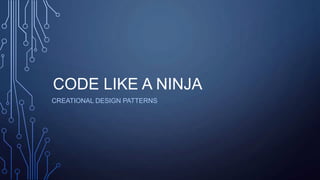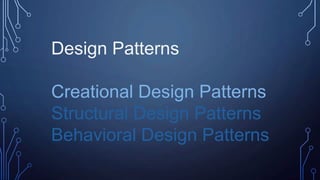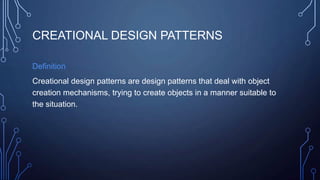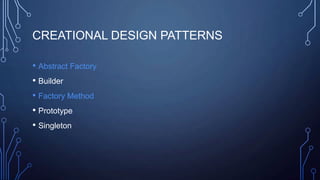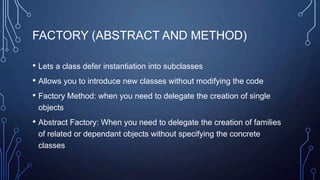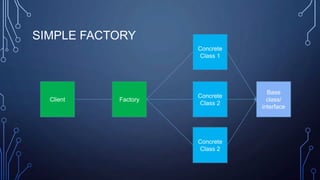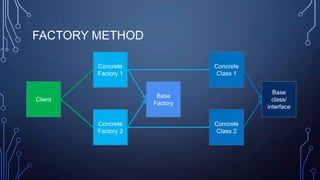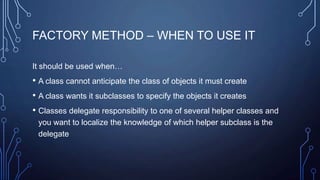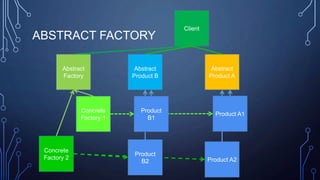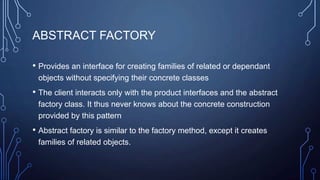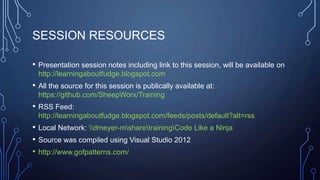Code Like a Ninja Session 7 - Creational Design Patterns
- 1. CODE LIKE A NINJA CREATIONAL DESIGN PATTERNS
- 2. SESSION RESOURCES • Presentation session notes including link to this session, will be available on http://learningaboutfudge.blogspot.com • All the source for this session is publically available at: https://github.com/SheepWorx/Training • RSS Feed: http://learningaboutfudge.blogspot.com/feeds/posts/default?alt=rss • Local Network: dmeyer-msharetrainingCode Like a Ninja • Source was compiled using Visual Studio 2012 • http://www.gofpatterns.com/
- 3. Design Patterns Creational Design Patterns Structural Design Patterns Behavioral Design Patterns
- 4. CREATIONAL DESIGN PATTERNS Definition Creational design patterns are design patterns that deal with object creation mechanisms, trying to create objects in a manner suitable to the situation.
- 5. • Abstract Factory • Builder • Factory Method • Prototype • Singleton CREATIONAL DESIGN PATTERNS
- 6. FACTORY (ABSTRACT AND METHOD) • Lets a class defer instantiation into subclasses • Allows you to introduce new classes without modifying the code • Factory Method: when you need to delegate the creation of single objects • Abstract Factory: When you need to delegate the creation of families of related or dependant objects without specifying the concrete classes
- 7. SIMPLE FACTORY Client Factory Concrete Class 1 Concrete Class 2 Concrete Class 2 Base class/ interface
- 8. SIMPLE FACTORY • Classes that need to be instantiated need to inherit from a common class (abstract class or interface) • The factory will receive some form of identifier and create the correct concrete class • Will return it via its base class (abstract class or interface)
- 9. SIMPLE FACTORY See simple factory code example Question(s): What will happen when we need to add new types
- 10. FACTORY METHOD Client Concrete Factory 1 Concrete Factory 2 Base Factory Concrete Class 1 Concrete Class 2 Base class/ interface
- 11. FACTORY METHOD • Classes you want to create must inherit from a base object (abstract class or interface) • Each class will have its own factory • The factories themselves will inherit off a base factory (abstract class) • Base factory will control behaviour while individual factories will be responsible for returning concrete instances of the desired class • If unique logic exists for a particular class, I recommend it be encapsulated within its factory
- 12. FACTORY METHOD – WHEN TO USE IT It should be used when… • A class cannot anticipate the class of objects it must create • A class wants it subclasses to specify the objects it creates • Classes delegate responsibility to one of several helper classes and you want to localize the knowledge of which helper subclass is the delegate
- 13. FACTORY METHOD – BENEFITS • Eliminates the need to bind application classes to your code The code only deals with the interface • Enables subclasses to provide an extended version of an object because creating an object inside a class is more flexible than creating the object directly in the client
- 14. FACTORY METHOD See factory method code example
- 15. ABSTRACT FACTORY Client Abstract Factory Abstract Product A Abstract Product B Concrete Factory 1 Concrete Factory 2 Product A2 Product B2 Product B1 Product A1
- 16. ABSTRACT FACTORY • Provides an interface for creating families of related or dependant objects without specifying their concrete classes • The client interacts only with the product interfaces and the abstract factory class. It thus never knows about the concrete construction provided by this pattern • Abstract factory is similar to the factory method, except it creates families of related objects.
- 17. ABSTRACT FACTORY – WHEN TO USE IT It should be used when… • The system should be independent of how its products are created, composed and represented • The system should be configured with one of multiple families of products • The family of related product objects is designed to be used together and you must enforce this constraint.
- 18. ABSTRACT FACTORY– BENEFITS • Isolates concrete classes • Makes exchanging product families easy • Promotes consistency among products
- 19. ABSTRACT FACTORY See abstract factory code example
- 20. SESSION RESOURCES • Presentation session notes including link to this session, will be available on http://learningaboutfudge.blogspot.com • All the source for this session is publically available at: https://github.com/SheepWorx/Training • RSS Feed: http://learningaboutfudge.blogspot.com/feeds/posts/default?alt=rss • Local Network: dmeyer-msharetrainingCode Like a Ninja • Source was compiled using Visual Studio 2012 • http://www.gofpatterns.com/
Editor's Notes
- Basic srpExposeutils class antipatternExpose singleton as a bad pattern to use (use at own risk)

